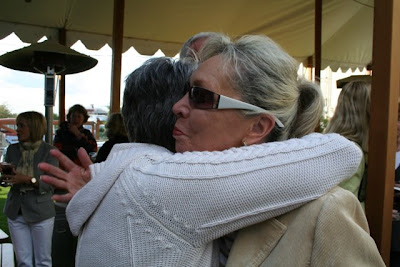
Joy presents me with a Recovery Buddy appropriately named Stormy.
When I'm interviewing animal rescuers, I've stopped asking if something horrible happened to them in the past.
Instead, I ask what happened.
Was it abuse? Neglect? Violence at the hands of human beings?
That's because I've noticed that people who risk their livelihoods, their health, even their own lives to save animals have usually been victims of trauma themselves, often from experiences that stretch back to their tender childhoods.
Whether it's because they identify passionately with the underdogs, or they have lost hope in human beings, the rescuers I've encountered turn to animals instead of people to find safe, rewarding, unconditional love.
My kind friend Joy is a dedicated animal lover. We first met when we landed on the scene of disaster in New Orleans in September 2005 following Hurricane Katrina's history-making devastation. We had both self-deployed to rescue the emaciated, injured animals left behind to die in a flooded wasteland devoid of people to care for them.
Like many of us, Joy has found a dangerous way to cope with her inner demons. Her soothing behavior of choice is self-injury. She began the behavior as a teenager.
Self-injurers might cut, burn, hit or scratch themselves. It's a disorder that mystifies many laypeople, who can't fathom inflicting pain on their bodies to bring comfort to their minds. But I understand Joy's actions. The physical pain she inflicts causes her to forget her mind's pain for a moment, and the distraction brings relief. It might also be an attempt to ease feelings of emptiness or numbness. The pain allows sufferers to feel alive because they are feeling something.
Joy -- who works as a veterinary technician -- recently spent a 30-day stint at a recovery clinic in Texas. That's where she discovered that a small item gave her big comfort.
Upon arrival at the clinic, she was handed a Recovery Buddy to help her through the difficult moments. Joy recalls clutching her yarn-covered soft toy as she weathered the lonely times away from friends and family.
Before I made the trip to visit Joy near her home, she asked me what my favorite colors were. I said black and blue. That's appropriate because I'm notorious for being a clumsy oaf.
And so, over a leisurely lunch, she presented me with Stormy, a black-and-blue Recovery Buddy she had knitted herself.
I was touched. The Buddies are knitted by survivors like Joy, who donate them to clinics around the country. The toys provide comfort to people battling a variety of mental health disorders.
The doll's appearance was apt on more than one level. Stormy sums up my circumstances right now. And don't forget -- Joy and I crossed paths in the aftermath of the most devastating storm in American history.
As I write this, Joy is madly knitting up a batch of 50 Recovery Buddies that are destined for an eating disorder clinic in Florida. She plans to enclose encouraging notes with words to comfort the recipients. Like them, she's been there.
Joy's found a way to make herself feel better. Instead of hurting herself, she's helping others.
And she's figuring out that this storm, too, will pass.




































